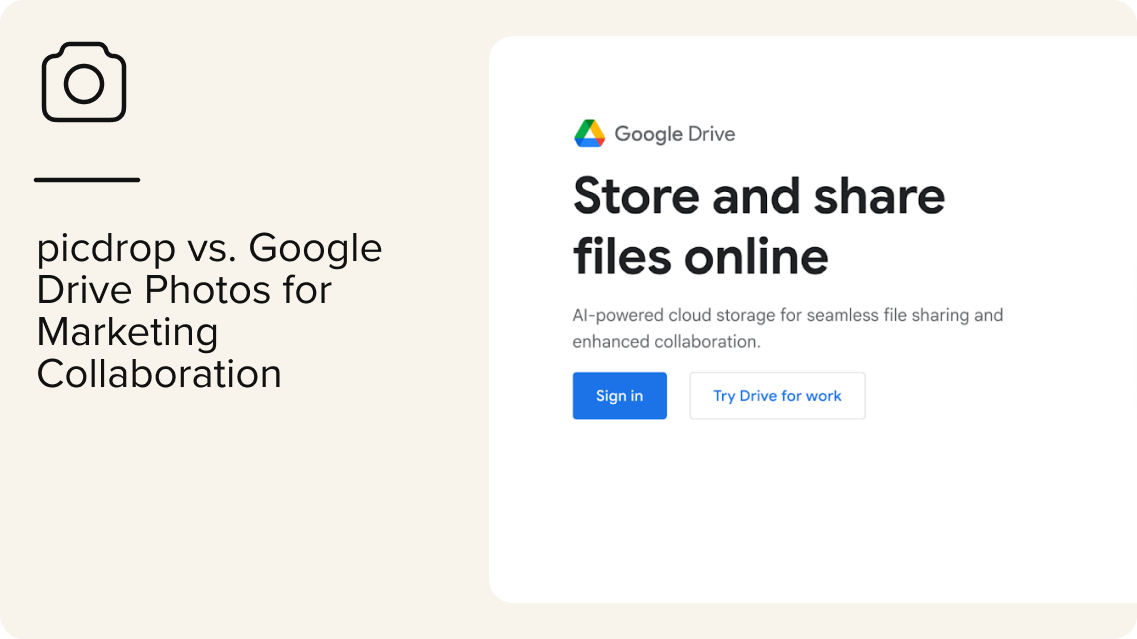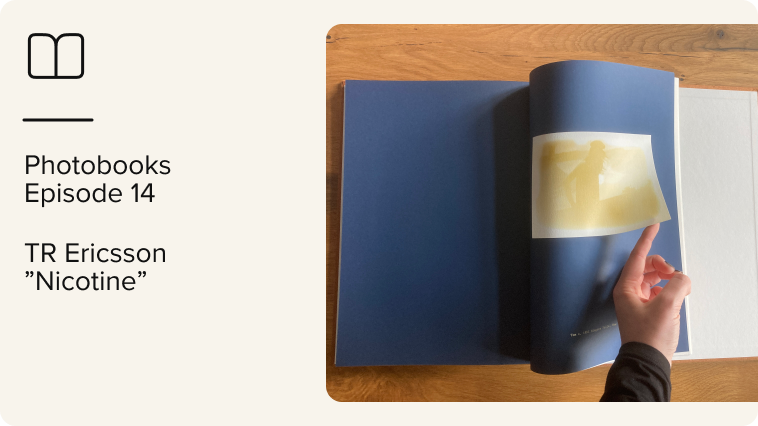Managing visual assets like photos and videos for marketing collaboration can quickly become overwhelming, especially when teams rely on tools like Google Drive Photos.
While it’s often the go-to option for basic cloud storage, Google Drive Photos lacks the specialized features marketing teams need for collaborative photo sharing. For example, visual feedback tools or file activity tracking. picdrop, by contrast, is built for marketers to manage comments and file version control. It’s a far more intuitive brand asset management system than Google Drive.
This blog compares picdrop and Google Drive Photos to help marketing teams choose the right platform for team collaboration, client photo proofing, and the organization of digital assets.
TL;DR: picdrop vs. Google Drive Photos for Client and Team Collaboration
- Marketing agencies and in-house teams often face challenges organizing visual assets, collaborating with creatives (e.g., photographers and editors), and delivering polished work to clients.
- Google Drive Photos offers basic file sharing and storage. It’s best suited for small marketing teams with minimal collaboration needs.
- picdrop is built specifically for image management, feedback, and sharing. It’s ideal for marketing teams juggling fast-paced, high-volume projects with multiple stakeholders.
Google Drive: Why It Falls Short for Visual-Based Marketing Collaboration
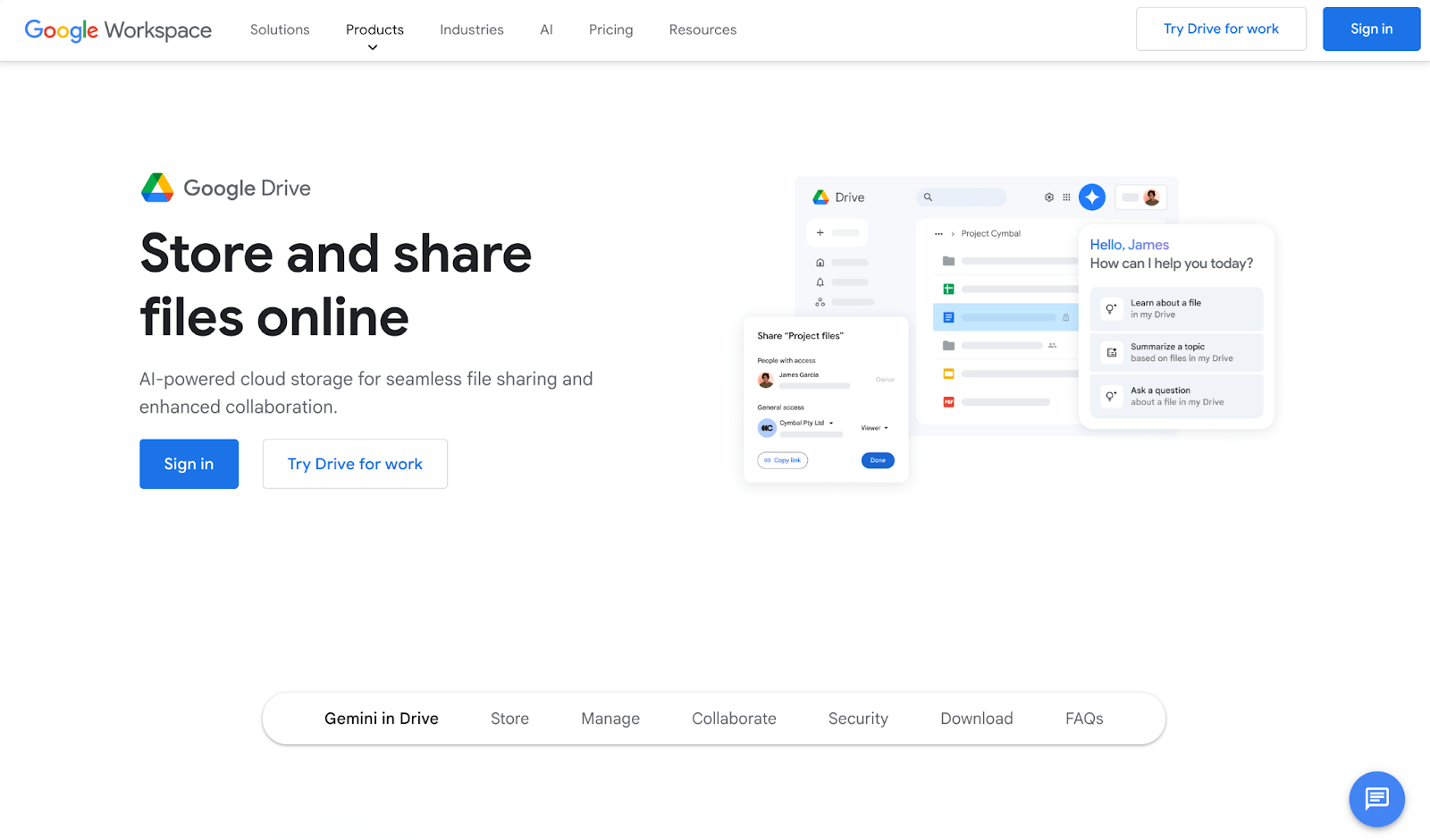
If your marketing team already works within the Google ecosystem, using Google Drive to manage marketing assets might feel like the obvious choice. It’s familiar and easy to access. However, while Google Drive Photos handles basic cloud storage well, it lacks the features needed for high-volume image management or creative projects.
Take the photo proofing stage, for example. After a product shoot, the client can only give feedback as plain text comments. Editing requests such as “darken the background here” are difficult to communicate without markup tools, easily leading to back-and-forth revisions. And when it’s time for clients to approve photos, they can’t mark favorites directly on the files. Instead, they must create separate lists in another tool, slowing the project turnaround.
Things get even more complicated for fast-moving marketing campaigns. Files are often updated within hours, but Google Drive Photos doesn’t provide clear activity tracking or file version management. That makes it hard to tell which photo or video is the latest approved version, increasing the risk of miscommunication and rework.
Without a structured collaboration tool, visual asset management using Google Drive Photos quickly becomes fragmented, slowing down your entire marketing production.
Pros of Google Drive Photos
- Tool familiarity and integration with Google Workspace.
- Basic file management features (create folders, file sorting, thumbnail view, etc.).
- Customizable file access permissions.
Cons of Google Drive Photos
- Text-based comments for photo and video feedback process.
- Generic cloud storage design, can’t be customized to match a client’s brand or marketing concept.
- No file tagging feature for easy file filtering and searching.
picdrop: An Image Management Tool for Collaborative Marketing
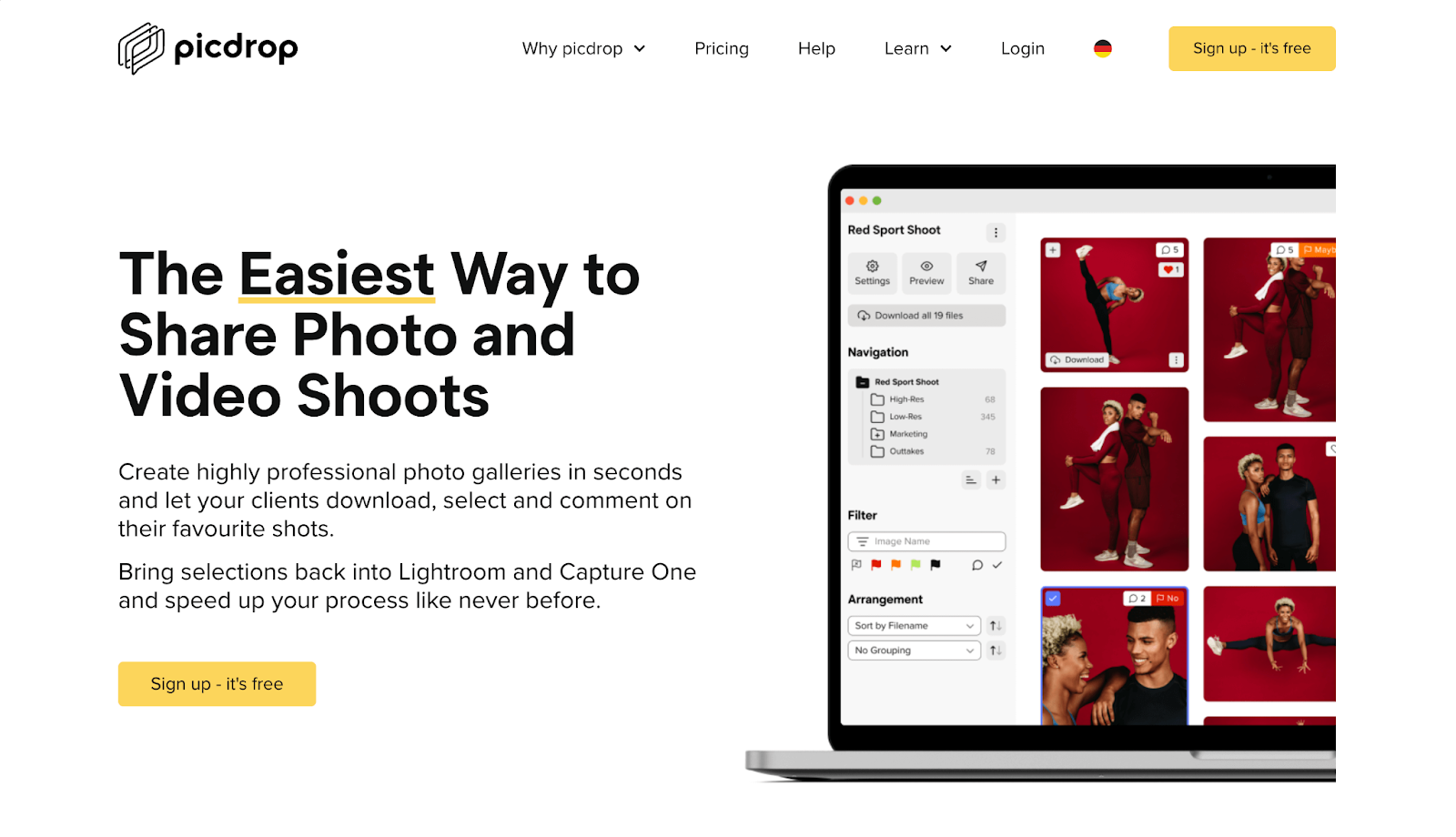
Unlike Google Drive, picdrop goes beyond basic file storage. Whether you’re managing product photo shoots, campaign videos, or brand illustrations, picdrop gives marketing teams the tools to work together efficiently.
With picdrop, teams and clients can leave comments and annotate directly on the images, making feedback clear, specific, and actionable. Everyone can point to exactly what needs to be changed. Clients can also mark their favorite shots directly in the image gallery, removing the need for separate lists or drawn-out approvals.
Additionally, picdrop’s real-time notifications keep your team in the loop with any project progress. You can instantly see who left a comment, who downloaded files, when stakeholders last checked in, and more. It’s a streamlined way to track progress, respond to requests, and keep marketing campaigns moving forward without bottlenecks.
Learn more about picdrop’s Collaboration Mode by watching this video:
Pros of Google Drive Photos
- Personalize the photo gallery design to enhance campaign concepts.
- Customize feedback system per gallery (e.g., allow or disallow comments, annotations, flagging, liking).
- Safeguard assets with watermarks, password protection, and a download disable option.
- Smart file filtering by flags (e.g., all photos marked with the ‘yes’ flag).
- Share photo galleries with partners via link or QR code.
Cons of picdrop
- No team tagging on comments (yet).
- No integration with project management tools (e.g., Asana, Trello).
picdrop vs. Google Drive Photos: Feature Comparison
After knowing the advantages and disadvantages of picdrop and Google Drive Photos, let’s put both tools side-by-side for a clearer comparison.
| Feature | Google Drive Photos | picdrop |
| Feedback system | Text-based comments only | Text-based comments and on-image annotations |
| File accessibility | Shared drives, customizable access permissions | Password-protected image galleries with a disabled file download option |
| File and team activity tracking | No tracking, only last modified information | Real-time notifications for downloads, photo likes, new comments, and more |
| Branding options | Generic cloud sharing platform looks | Customizable gallery design (background color, layout, font styles, and image spacing) |
Our feature verdict:
If you rely heavily on client feedback and team collaboration, we recommend picdrop over Google Drive. While Google Drive serves as a basic storage solution, picdrop goes further. It combines digital asset management with built-in visual feedback tools and seamless file sharing. It’s built for creative marketing projects where clarity and speed matter.
picdrop vs. Google Drive Photos: Pricing Comparison
Google Drive Photos Pricing and Storage Limits
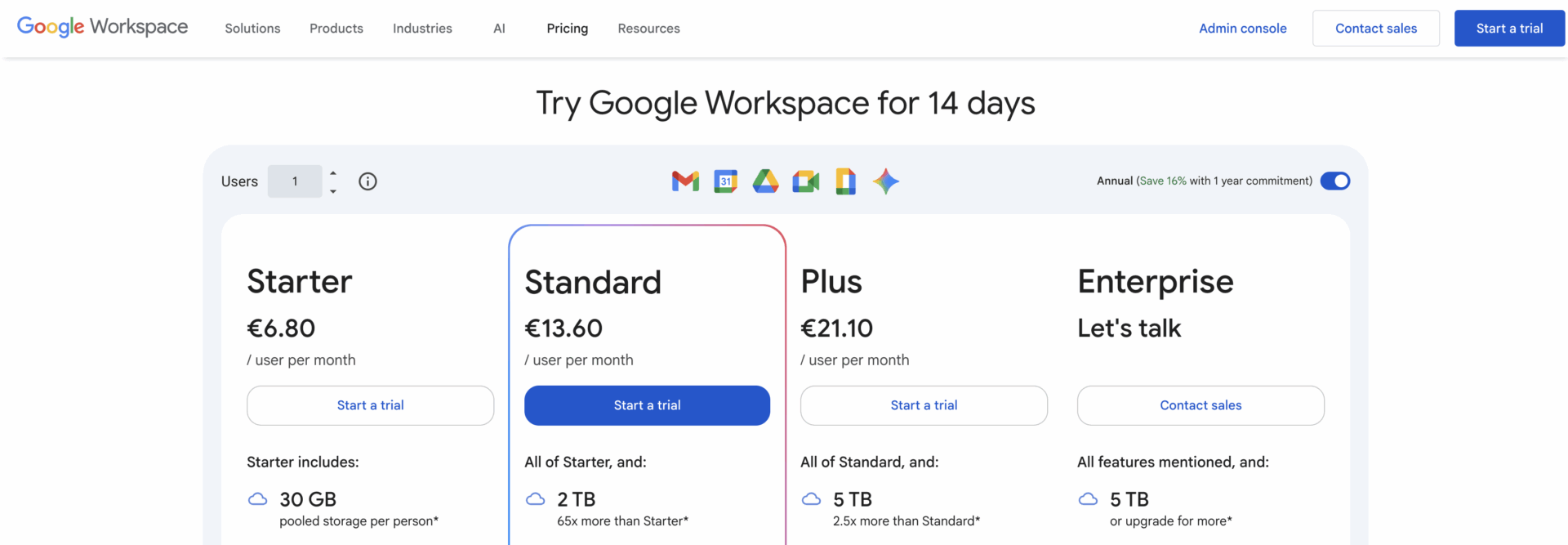
Depending on your Google account’s plan, you have different storage limits. Below are the prices for the Google Workspace Business models with a one-year commitment. Keep in mind that Google Drive storage is shared with other Google products, such as Google Docs, Sheets, and Slides.
- Free: €0 per user per month for 15 GB storage.
- Starter: €6.80 per user per month for 30 GB storage.
- Standard: €13.60 per user per month for 2 TB storage.
- Plus: €21.10 per user per month for 5 TB storage.
- Enterprise Plus: custom pricing.
While these storage plans might seem enough for general documents or light brand asset storage, they can quickly hit their limit, especially for hosting large-scale video projects.
Google Drive has a 750 GB daily upload limit, and individual files can’t exceed 5 TB. One marketing video shot in 4K resolution or uncompressed formats can easily exceed those limits. Once you hit the cap, video uploads stop, forcing teams to wait or break up files, interrupting production flow.
picdrop Pricing and Value for Marketing Teams
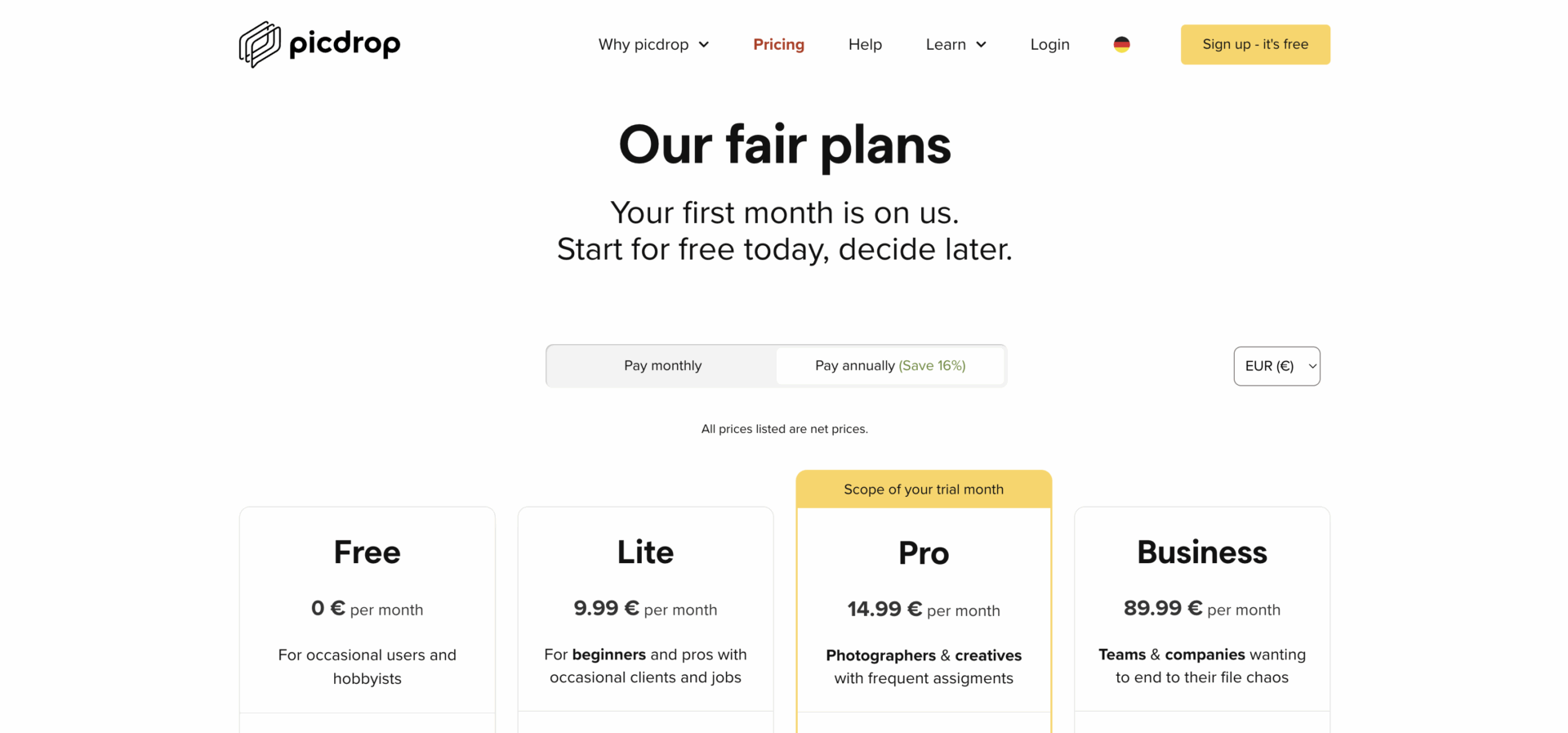
picdrop offers both a forever-free plan and paid subscriptions. Below are the annual subscription fees and their storage limits:
- Free: €0 per month for 1 GB storage, 1 user.
- Lite: €9.99 per month for 10 GB storage, 1 user.
- Pro: €14.99 per month for 500 GB storage, 2 users.
- Business: from €89.99 per month for 1000 GB storage, 3 to 15+ users.
Get more details on the features available for each plan on picdrop’s pricing page.
Our pricing verdict:
If you require basic storage needs, Google Drive’s lower-tier plans offer more generous storage at a lower price. However, for creative and marketing teams with multiple team members that need more than just storage (e.g., built-in feedback, collaboration tools, and client-ready galleries), picdrop delivers significantly more value, especially at the Pro and Business tiers.
picdrop: the Best Brand Asset Management Tool for Marketers
If you’re looking for a better way to share, collaborate on, and manage your marketing project assets, picdrop is a great alternative to Google Drive Photos.
Not only does picdrop help your team stay organized, it also elevates how your brand presents itself to clients and stakeholders. From polished asset galleries to clear feedback loops, picdrop helps your marketing work look as good as it performs.
Sign up for picdrop’s free plan and experience smoother marketing project turnarounds.
FAQs About picdrop vs. Google Drive Photos for Marketing Teams
1. What is a Great Google Drive Alternative for Marketing Teams?
picdrop is an excellent alternative to Google Drive, especially if your marketing team frequently shares visuals and collects feedback. picdrop is built specifically for creative collaboration, making it easier to manage campaigns, review assets, and keep everything visually aligned. Learn more about picdrop’s features.
2. How Can picdrop Improve the Creative Asset Management of My Marketing Team?
picdrop simplifies how marketing teams organize, share, and review marketing content, including photos, videos, and graphic images. For instance, you can create dedicated galleries for each project, control file access, and receive clear client feedback, all in one platform. This reduces back-and-forth workflow, keeps everyone aligned, and helps move projects forward faster.
3. Does picdrop Offer a Free Plan, and How Does It Compare to Google Drive’s Free Plan?
Yes, picdrop offers a forever-free plan with 1 GB of storage. While that may be smaller than Google Drive’s 15 GB, picdrop’s free tier includes features you won’t find in Google Drive. These are real-time team activity tracking, file revision logs, and password-protected sharing links. For marketing teams, these features can be more valuable than extra storage space.
